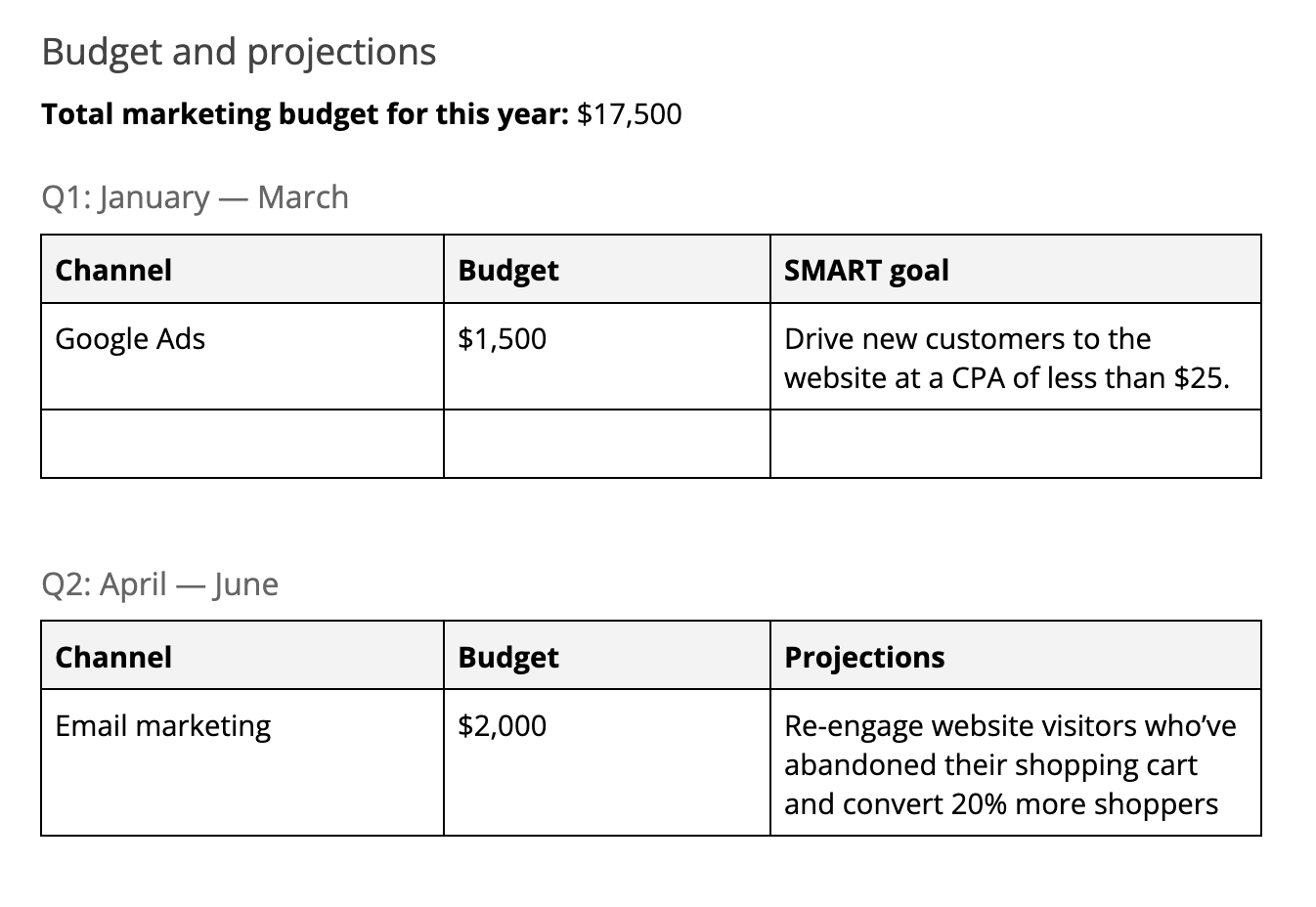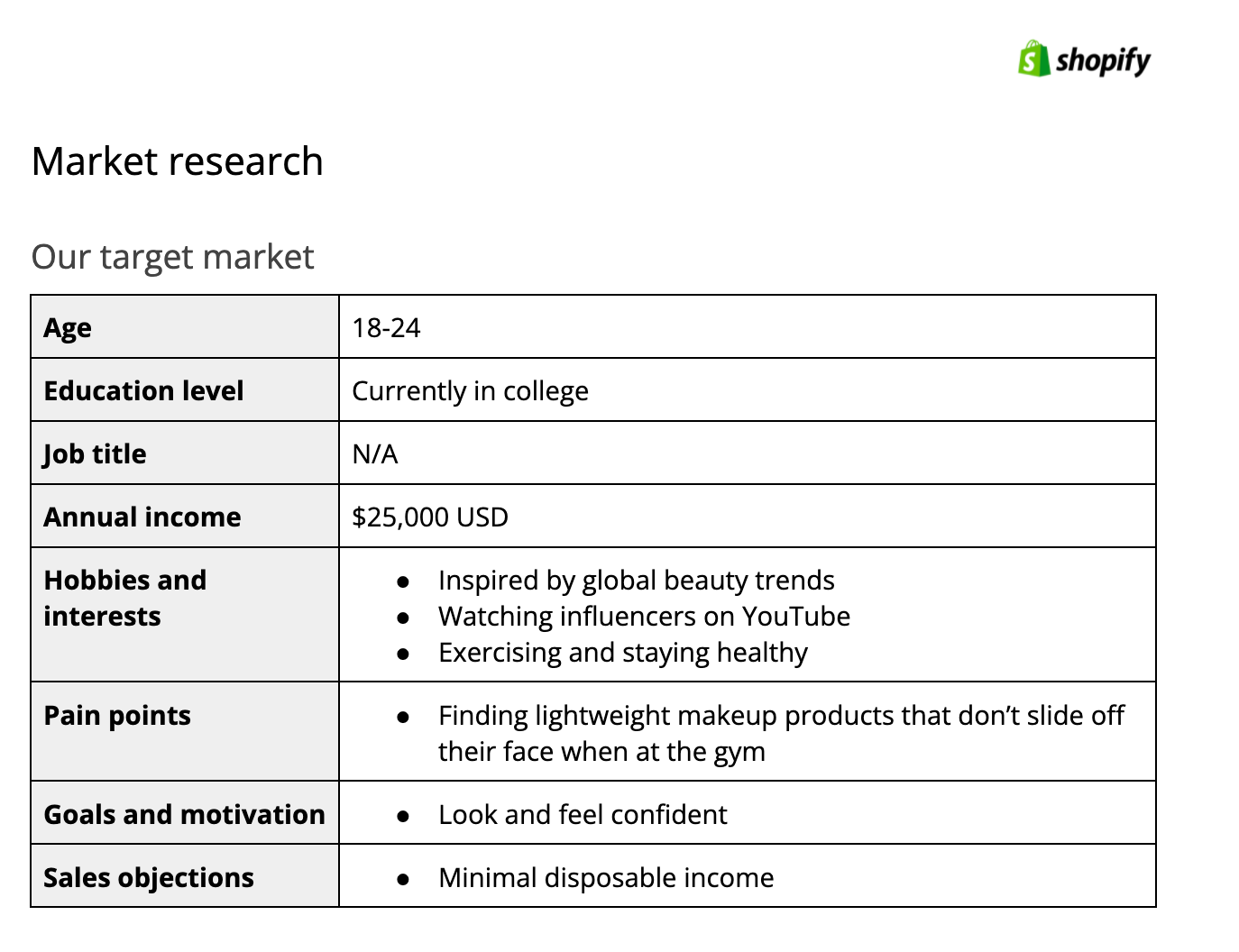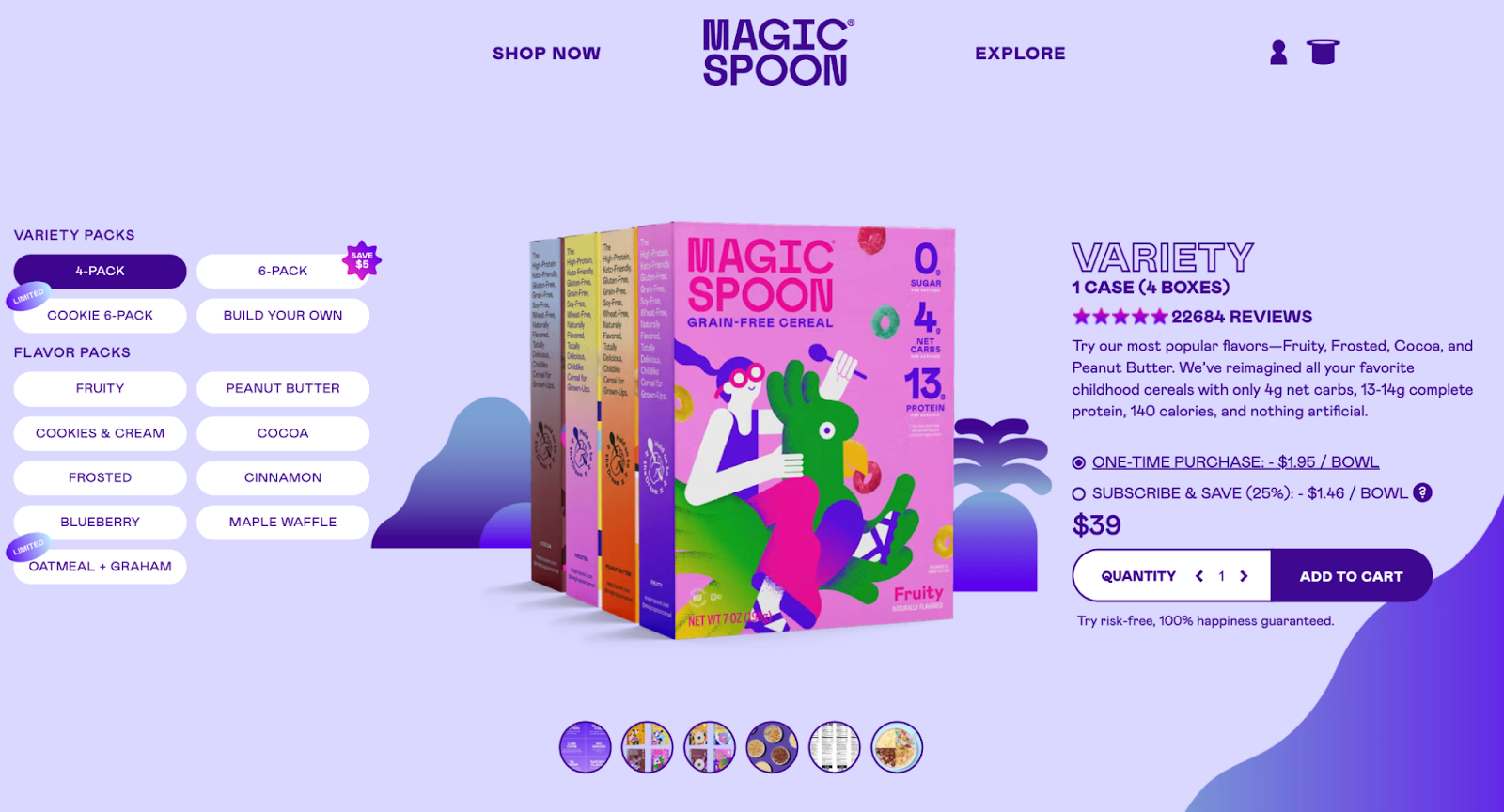Behind every scalable online business is a solid marketing plan.
That’s why putting one together using this marketing plan template can help maximize your marketing spend, and track your marketing tactics, goals and costs. Without one, even the best marketing ideas end up being like spaghetti thrown at a wall: nothing sticks.
Often, the hardest part of planning is knowing where to start, and that’s where this guide comes in. Here’s a marketing plan template to help you get your marketing strategy down on paper.
This marketing plan template can help you to stay on track—and on budget—as you prepare for another year of creative campaigns and experimental ideas.
Table of contents
What is a marketing plan template used for?
A marketing plan template provides structure and guidance to create marketing plans. A well-developed and successfully implemented marketing plan can help you reach new customers, increase sales, and build brand awareness. Additionally, marketing plans help identify customer needs and preferences, as well as track and measure the success of marketing campaigns, ultimately helping a business reach its goals and objectives.
How to fill out a marketing plan template
- Write an executive summary
- Set your budget and projections
- Conduct market research
- Develop a marketing strategy
- Set up plans for measurement and reporting
- Stay on track
On its own, a marketing plan template isn’t going to catapult you into the marketing campaign hall of fame. It’s what you write inside that counts. The more time and effort you put into an actionable marketing plan, the more you set your business up for success by operating under a well thought out marketing strategy. Here are the steps to get you on your way:
1. Write an executive summary
Your marketing plan should start with an executive summary that includes the important elements such as marketing objectives, goals, and the people on your marketing team. Your executive summary should include:
- Company name. The registered business name of your company.
- Year founded. The year you started your business.
- Location. Where is your headquarters? If you’re a store with several locations, list them here.
- Mission statement. Your mission statement is a one-liner that explains why your business exists. Starbucks, for example, uses the following mission statement: “Our mission, with every cup, with every conversation, with every community—we nurture the limitless possibilities of human connection.”
- Business objectives. What do you hope to achieve in the coming year? Most often, business goals include financial projections or big-picture plans, like opening a physical store or launching a new product line.
- Marketing goals. How do you plan to achieve those company goals with your marketing strategy? This could be anything from “Increase brand awareness with a social media strategy” to “Improve customer return rate.”
- Marketing team. List the name, job title, and responsibility of everyone in your marketing department—including key stakeholders such as the marketing director and marketing strategist. This will keep the team accountable and make the marketing plan operational.
2. Set your budget and projections
Assess how much money you have to play with when executing your marketing plan. Use the marketing plan template to detail your total budget for the year.
For each quarter, list the channel you plan to use alongside a budget and SMART goal (meaning it’s specific, measurable, achievable, relevant, and timely) for tracking. For example, if you’re using Google Ads to promote new products, your budget might be $1,500 per quarter. The SMART goal could be “Drive new customers to the website at a CPA of less than $25.”

3. Conduct market research
Market research can help you uncover buyer personas, get to know what your target customers care about, find product-market fit, and conduct some competitive analysis.
Your marketing plan, with help from this template, will detail the way to do market research on your audience—such as surveying previous customers, evaluating analytics, and browsing social media.
Figure out your target market
To successfully market to new customers, you need a solid understanding of your target audience: who they are, what they like, and where they hang out online. That’s where market research comes in.
“If you understand who this group of people is and what set of experiences they have, you can relate to them through shared experiences,” says Smart Marketer founder Ezra Firestone.
Once you go through the process of developing a buyer persona and better learning who your target market is and what interests them, you’ll be better suited to market to them in a way that resonates.
Develop buyer personas, and prepare future marketing messaging, by considering:
- Age. Which demographic purchases your product the most?
- Education level. Did they graduate from high school? Are they college educated? The education level of your target audience helps fine-tune your messaging.
- Job title. If you’re selling to a business, list the job title someone purchasing your products would have—such as “merchandising manager.”
- Annual income. How much does your target customer earn per year? Those with lots of disposable income are more likely to buy premium products.
- Hobbies and interests. What does your target customer do for fun? Tying your product in with those activities can help you secure market share.
- Pain points. What problems does your product solve? For example, Joe Markham, owner of KONG, created a pet chew toy after struggling to find an alternative to the rocks and sticks his dog used when teething.
- Goals and motivations. What does your target audience want to achieve in life? Ideally, your product will play a role in helping them reach it.
- Sales objections. What pain points do your customers run into that may prevent them from purchasing? Common sales objections include price, lack of trust, and lack of urgency. Brainstorm ways to overcome these objections in this part of your marketing plan template.

Do competitive analysis
Get insight into your customers’ purchase process and the triggers that would cause them to purchase your products by entering the following information on your marketing plan template. (Repeat this competitor analysis for your business/product and up to three competitors.)
- Unique selling proposition (USP). What’s the one fundamental part of your product that makes it better than any other option available to a customer? This concept is called the unique selling proposition, or USP.
- Tagline. A short, descriptive sentence that people associate with your products—like Nike’s “Just Do It.” Use Shopify’s free slogan maker if you’re still unsure of yours.
- Product price. How much does your product sell for? Benchmark its price against the competition. A more expensive product can still sell if you can prove to customers that it’s worth the extra money. Once you decide on pricing, you should also detail your pricing strategy in your marketing plan.
- Sales channels. Where do competitors sell their products? Whether it’s in stores, at trade shows, through Facebook Shops, or via marketplaces, list your sales channels in this section.
- Marketing channels. Which marketing channels do your competitors use for their marketing activities? From social media to search engine optimization (SEO), this section shows the channels you should consider in your marketing plan.
- Audience size. For each marketing channel used by a competitor, jot down how many followers they have. A competitor crushing it on Instagram likely means you can add the same social media platform to your own marketing mix.
- Messaging. How does each competitor position their product? Cereal company Magic Spoon, for example, uses clever copywriting to communicate with health-conscious adult customers. Its products are described by the phrase “Childhood classics. Grown-up ingredients.”

Conduct a SWOT analysis
Run a SWOT analysis to uncover your:
- Strengths. Where does your business or product excel? This could be anything from a diverse supplier list to owned intellectual property.
- Weaknesses. Which areas of your business do you struggle with? For small businesses, this may be a small customer list or lack of awareness outside your own country.
- Opportunities. What external factors could positively impact your business? These are often outside of your control, such as increasing consumer awareness of the problem you solve or a competitor’s declining market share.
- Threats. What external factors could negatively impact your business? These, too, are often outside of your control, such as declining market size or a change in regulations.
4. Develop a marketing strategy
This section of your marketing plan template details the marketing strategy you’ll use to reach your target market, grow your business, and make sales.
Include each marketing channel you’re using—such as SEO, email marketing, and content marketing—and each social media channel you plan to be active on, for both paid and organic.
Tip: As you develop marketing strategies for each of your marketing channels, remember to integrate the findings from your competitive analysis.
- Stage of the marketing funnel. Which stage of the marketing funnel is each channel designed to reach? Social media posts are typically for those at the top of the funnel, whereas email marketing campaigns might aim to convert those sitting at the bottom.

- Budget. How much money do you have to spend on each marketing channel? Get granular with each channel so you know exactly how you plan to spend your overall marketing budget.
- Software and equipment required. Which apps do you need access to for each channel? Consider associated costs in your budget. If you’re hosting Facebook livestreams, for example, you’ll need a high-quality webcam and microphone.
- SMART goal. What do you want to achieve through each marketing channel? Make it specific, measurable, achievable, relevant, and time-bound (SMART)—like “Increase X (formerly Twitter) reach by 50% in Q1.”
5. Set up plans for measurement and reporting
Set a reminder to check in on the progress of your marketing efforts. It’s the best way to make sure you improve on next year’s digital marketing campaigns.
For each channel and objective, set key performance indicators (KPIs) at the beginning of each quarter. Whether you hit them or not will give you insights into whether your strategy is making headway toward your goals. If that’s “Increase search traffic via SEO,” for example, record the number of organic visitors arriving to your website each day.
After your campaign has ended, take stock of the data you collected. If you achieved your marketing goal, explain why. Using the same SEO example, you might say, “We met our goal of increasing organic traffic by 10% each quarter. Our investment in internal linking, optimizing product pages, and writing blog content paid off. We plan to continue this in 2024.”
For strategies that didn’t go as planned, explain the reason you fell behind and how you’ll rectify it next time.
If you failed to reduce the cost per lead (CPL) of Facebook ads, for example, your analysis could be: “We didn’t meet our expectations of reducing cost per lead via Facebook ads by 20%. We think this is because consumers were oversaturated with ads in the lead-up to Black Friday. We’ll fix this in 2024 by starting the campaign earlier and developing more visually striking ads. We’ll also lean on the expertise of a marketing agency, if budget allows.”

6. Stay on track
Whether you’re just getting started or scaling an existing ecommerce business, planning is key to healthy, sustainable growth. A little upfront investment of your time can pay dividends in the long run—especially when you build a solid marketing plan that turns into a marketing machine that hits all of your objectives (and more).
Marketing plan template FAQ
Why is a marketing plan important?
A marketing plan is important because it is a blueprint for achieving marketing objectives. It does the following:
- Outlines the marketing strategies, tactics, and actions that will be taken to reach goals.
- Helps ensure that resources are used in the most efficient and effective manner.
- Keeps a company focused on its desired outcomes.
By having a plan in place, a company can track its progress and make adjustments as needed.
Does every business need a marketing plan?
Yes, every business should have a marketing plan. A marketing plan helps a business set goals, allocate resources, and measure success. It provides a roadmap for the business to follow and helps the business stay focused on its objectives.
How effective are marketing plan templates?
Marketing plan templates can be very effective when filled out properly. They provide structure and guidance for businesses to reach their goals and objectives.
Are marketing plans the same as business plans?
No, marketing and business plans are not the same. Business plans are documents describing a business, its products or services, how it will make money, its financing, its business model, and more. You can build one using one of our free business plan templates. Marketing plans are blueprints for achieving marketing objectives and building a solid marketing strategy.













